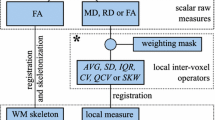Abstract
Quantitative analysis on diffusion tensor imaging (DTI) has shown be useful in the study of disease-related degeneration. More and more studies perform voxel-by-voxel comparisons of fractional anisotropy (FA) values, aiming at detecting white matter alterations. Overall, there is no agreement about how the normalization stage should be performed. The purpose of this study was to evaluate the effect of the normalization strategy on voxel-based analysis of DTI images, using the performance of a classification approach as objective measure of normalization quality. This is achieved by using a Support Vector Machine (SVM) which constructs a decision surface that allows binary classification with two types of regions, generated after a statistical evaluation of the grey level values of regions detected as statistically significant in a FA analysis.
Access this chapter
Tax calculation will be finalised at checkout
Purchases are for personal use only
Preview
Unable to display preview. Download preview PDF.
Similar content being viewed by others
References
Friston, K.J., Ashburner, J.T., Kiebel, S., Nichols, T.E., Penny, W.D. (eds.): Statistical Parametric Mapping: The analysis of functional brain images. Academic Press, London (2007)
Ashburner, J.: Computational anatomy with the spm software. Magnetic Resonance Imaging 27, 1163–1174 (2009)
Kubicki, M., McCarley, R., Westin, C., Park, H., Maier, S., Kikinis, R., Shenton, M., Jolesz, F.: A review of diffusion tensor images un schizophrenia. Journal of psychiatric research 41, 15–30 (2007)
Chao, T., Chou, M., Yang, P., Chung, H., Wu, M.T.: Effects of interpolation methods in spatial normalization of diffusion tensor imaging data on group comparison of fractional anisotropy. Magnetic Resonance Imaging 27, 681–690 (2008)
Focke, N.: Voxel-based diffusion tensor imaging in patients with mesial temporal lobe epilepsy and hippocampal sclerosis. Neuroimage 40, 728–737 (2008)
Kunimatsu, A.: Utilization of diffusion tensor tractography in combination with spatial normalization to asses involvement of the corticospinal tract in capsular/pericapsular stroke: feasibility and clinical implications. Magnetic Resonance Imaging 26, 1399–1404 (2007)
Snook, L.: Voxel based versus region of interest analysis in diffusion tensor imaging of neurodevelopment. Neuroimage 34, 243–252 (2007)
Pell, G., Pardoe, H., Briellmann, R., Abbott, D., Jackson, G.: Sensitivity of voxel-based analysis of dti images to the warping strategy. In: Proceedings of the International Society for Magnetic Resonance in Medicine (2006)
Kloppel, S., Draganski, B.V., Golding, C., Chu, C., Nagy, Z., Cook, P.A., Hicks, S.L., Kennard, C., Alexander, D.C., Parker, G.J.M., Tabrizi, S.J., Frackowiak, R.S.J.: White matter connections reflect changes in voluntary-guided saccades in pre-symptomatic huntington’s disease. Brain Advance (2007)
Caprihan, A., Pearlson, G., Calhoun, V.: Application of principal component analysis to distinguish patients with schizophrenia from healthy controls based on fractional anisotropy measurements. Neuroimage 42, 675–682 (2008)
Freidlin, R.Z., Ozarslan, E., Assaf, Y., Komlosh, M.E., Basser, P.J.: A multivariate hypothesis testing framework for tissue clustering and classification of dti data. NMR in Biomedicine 22, 716–729 (2009)
Fan, Y., Shen, D.: Integrated feature extraction and selection for neuroimage classification. In: Proceedings of SPIE (2009)
Kloppel, S., Stonnington, C.M., Chu, C., Draganski, B., Scahill, R.I., Rohrer, J.D., Fox, N.C., Jack Jr., C.R., Ashburner, J., Frackowiak, R.S.J.: Automatic classification of mr scans in alzheimer’s disease. Brain Advance Access (2008)
Plant, C., Teipel, S.J., Oswald, A., Bohm, C., Meindl, T., Mourao-Miranda, J., Bokde, A.W., Hampel, H., Ewers, M.: Automated detection of brain atrophy patterns based on mri for the prediction of alzheimer’s disease. NeuroImage (2009)
Platt, J.C.: Fast training of support vector machines using sequential minimal optimization. In: Advances in kernel methods: support vector learning, pp. 185–208. MIT Press, Cambridge (1999)
Author information
Authors and Affiliations
Editor information
Editors and Affiliations
Rights and permissions
Copyright information
© 2010 Springer-Verlag Berlin Heidelberg
About this paper
Cite this paper
Díaz, G. et al. (2010). The Effect of the Normalization Strategy on Voxel-Based Analysis of DTI Images: A Pattern Recognition Based Assessment. In: Yao, Y., Sun, R., Poggio, T., Liu, J., Zhong, N., Huang, J. (eds) Brain Informatics. BI 2010. Lecture Notes in Computer Science(), vol 6334. Springer, Berlin, Heidelberg. https://doi.org/10.1007/978-3-642-15314-3_8
Download citation
DOI: https://doi.org/10.1007/978-3-642-15314-3_8
Publisher Name: Springer, Berlin, Heidelberg
Print ISBN: 978-3-642-15313-6
Online ISBN: 978-3-642-15314-3
eBook Packages: Computer ScienceComputer Science (R0)




